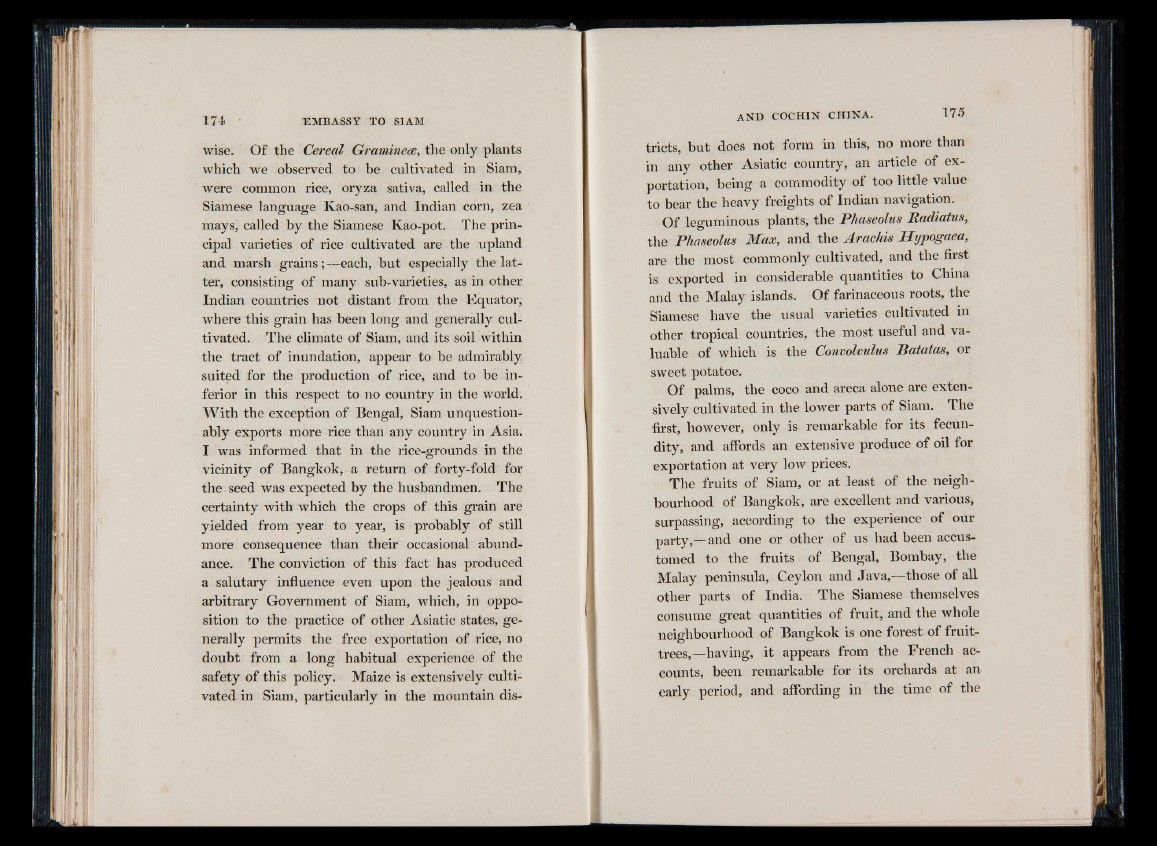
wise. Of the Cereal Graminece, the only plants
which we observed to be cultivated in Siam,
were common rice, oryza sativa, called in the
Siamese language Kao-san, and Indian corn, zea
mays, called by the Siamese Kao-pot. The principal
varieties of rice cultivated are the upland
and marsh grains;—each, but especially the latter,
consisting of many sub-varieties, as in other
Indian countries not distant from the Equator,
where this grain has been long and generally cultivated.
The climate of Siam, and its soil within
the tract of inundation, appear to be admirably
suited for the production of rice, and to be inferior
in this respect to no country in the world.
With the exception of Bengal, Siam unquestionably
exports more rice than any country in Asia.
I was informed that in the rice-grounds in the
vicinity of Bangkok, a return of forty-fold for
the seed was expected by the husbandmen. The
certainty with which the crops of this grain are
yielded from year to year, is probably of still
more consequence than their occasional abundance.
The conviction of this fact has produced
a salutary influence even upon the jealous and
arbitrary Government of Siam, which, in opposition
to the practice of other Asiatic states, generally
permits the free exportation of rice, no
doubt from a long habitual experience of the
safety of this policy. Maize is extensively cultivated
in Siam, particularly in the mountain districts,
but does not form in this, no more than
in any other Asiatic country, an article of exportation,
being a commodity of too little value
to bear the heavy freights of Indian navigation.
Of leguminous plants, the Phaseolus Radiatus,
the Phaseolus Max, and the Arachis Hypogaea,
are the most commonly cultivated, and the,first
is exported in considerable quantities to China
and the Malay islands. Of farinaceous roots, the
Siamese have the usual varieties cultivated in
other tropical countries, the most useful and valuable
of which is the Convolvulus Batatas, or
sweet potatoe.
Of palms, the coco and areca alone are extensively
cultivated in the lower parts of Siam. The
first, however, only is remarkable for its fecundity,
and affords an extensive produce of oil for
exportation at very low prices.
The fruits of Siam, or at least of the neighbourhood
of Bangkok, are excellent and various,
surpassing, according to the experience of our
party,—and one or other of us had been accustomed
to the fruits of Bengal, Bombay, the
Malay peninsula, Ceylon and Java,—those of all
other parts of India. The Siamese themselves
consume great quantities of fruit, and the whole
neighbourhood of Bangkok is O 0 one forest of fruittrees,—
having, it appears from the French accounts,
been remarkable for its orchards at an
early period, and affording in the time of the